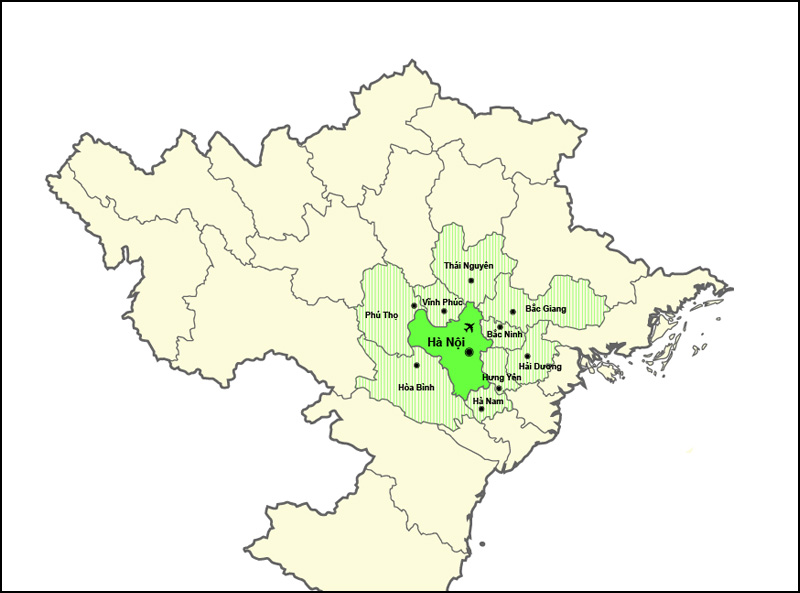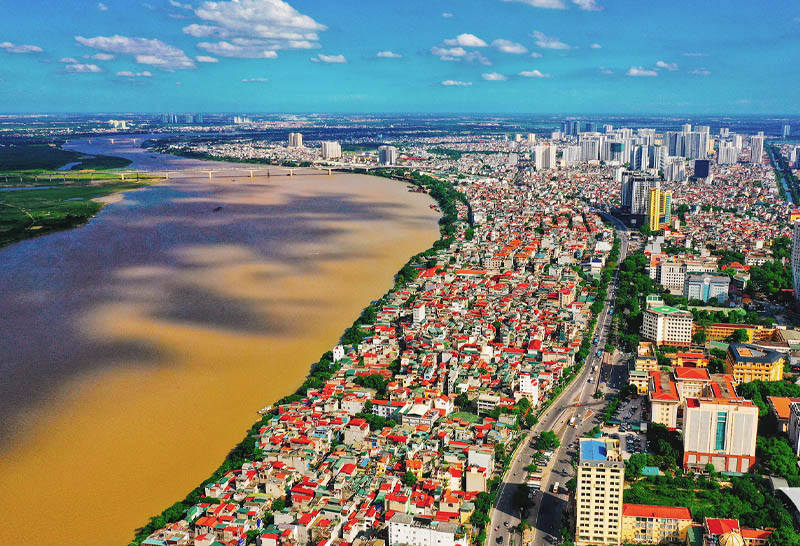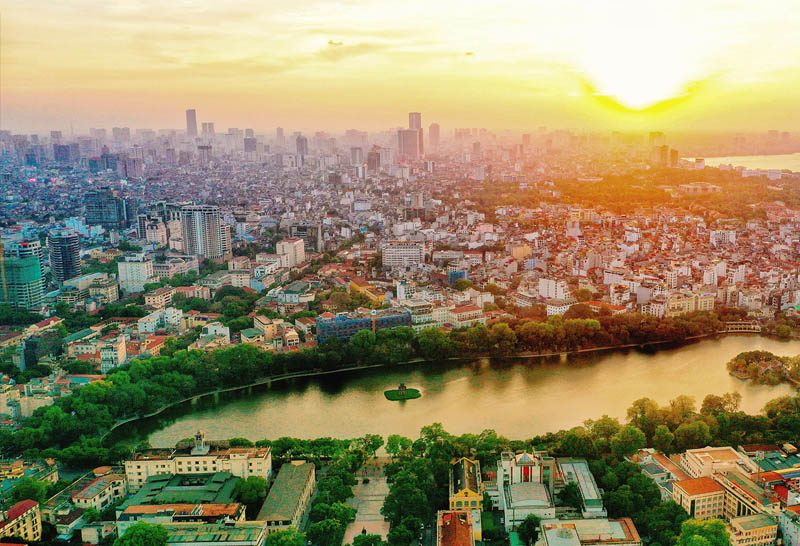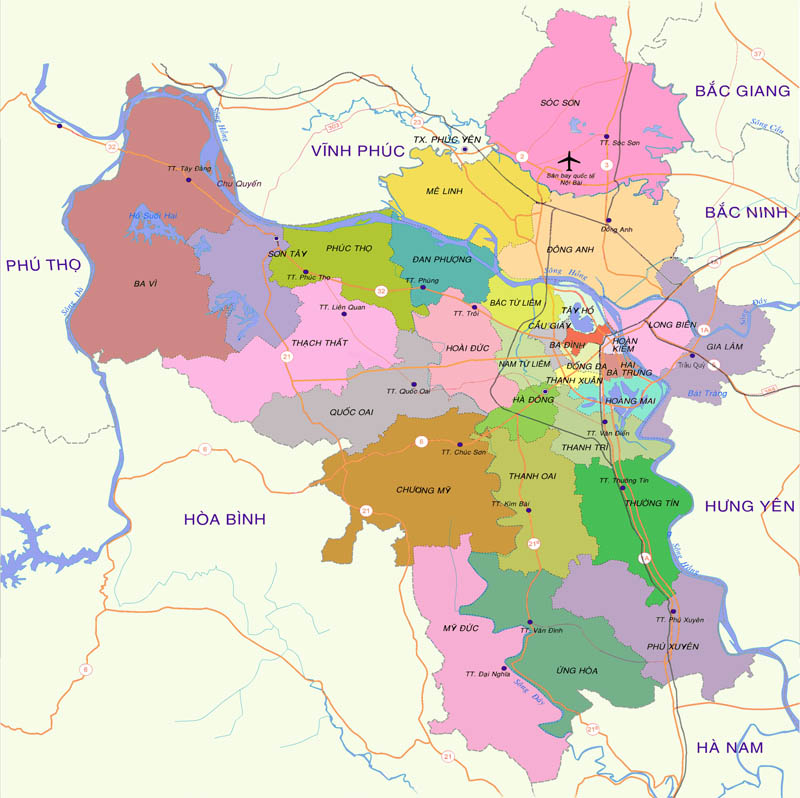What is the Total Area of Hanoi?

Hanoi, the capital of Vietnam, is renowned for its expansive area and diverse urban landscape. The total area of Hanoi is estimated at approximately 3,359.82 km², making it the largest city in the country by land area. With its vast expanse, Hanoi boasts numerous advantages for economic, cultural, social development, as well as significant potential for tourism growth in the region.
Table of Contents
1. What is the current area of Hanoi city?
According to statistics from 2020, Hanoi covers an area of 3,359.82 km², accounting for approximately 1% of the country’s total land area. As of December 2022, the estimated average population of Hanoi is around 8.4 million people. This makes it the largest centrally controlled city in Vietnam by land area.

Before 1975, Hanoi covered an area of approximately 584 km², with a population of 91,000. Following the resolution to adjust the administrative boundaries of Hanoi approved by the National Assembly of Vietnam on May 29, 2008, the entire province of Ha Tay, Me Linh district (Vinh Phuc province), four communes in Luong Son district (Hoa Binh province) were officially merged into Hanoi. Consequently, Hanoi’s area increased to 3,324.92 km², placing it among the top 17 largest capitals in the world.
Situated in the Red River Delta, Hanoi has long been recognized as the political, economic, cultural and social center of the region since the early days of the nation’s establishment. On the map, it is evident that the majority of Hanoi’s area lies within the low-lying and flat delta region, with an average elevation of 5 to 20 meters above sea level. Of the total area of 3,324.92 km², the low and flat delta comprises approximately three-quarters, enriched by the sediments from major river branches. The remaining area consists of hilly terrain, predominantly located in the western and northern outskirts of the city.

2. How does Hanoi’s area rank in the country?
With a total natural area of 3,324.92 km², Hanoi city is currently the largest centrally run city in the country. In addition, Hanoi also ranks 41st in area among the 63 provincial-level administrative units under Vietnam. Compared to other countries in the world, the capital Hanoi is also in the top 17 largest capitals in the world with an area of over 3,000 km2.

The vast area of Hanoi facilitates the development of new urban areas and the improvement of urban infrastructure. Additionally, the city has ample space for establishing industrial parks and clusters, attracting investment capital and creating numerous job opportunities for residents. Alongside the rapid population growth, the expansive urban area also contributes to meeting the increasing housing demand in Hanoi.
3. Latest updated area of Hanoi districts
After expanding the administrative boundaries in 2008, the area of Hanoi capital is 3,324.92 km². The city is divided into 30 district-level administrative units, including:
- 12 districts: Cau Giay, Thanh Xuan, Hoang Mai, Dong Da, Ha Dong, Hai Ba Trung, Ba Dinh, Hoan Kiem, Long Bien, Tay Ho, Nam Tu Liem and Bac Tu Liem.
- 17 districts: Ba Vi, Thach That, Gia Lam, Dan Phuong, Thuong Tin, Chuong My, Hoai Duc, Me Linh, Thanh Tri, Thanh Oai, My Duc, Soc Son, Phuc Tho, Dong Anh, Phu Xuyen, Quoc Oai , Ung Hoa.
- 1 town is Son Tay town.

Below is the latest summary table of the area of Hanoi districts:
AREA OF HANOI DISTRICTS AND DISTRICTS
| No | District | Area (km2) | Number of wards and communes |
| 1 | Ba Dinh district | 9,21 | 14 wards |
| 2 | Bac Tu Liem District | 45,24 | 13 wards |
| 3 | Cau Giay District | 12,44 | 8 wards |
| 4 | Dong Da district | 9,95 | 21 wards |
| 5 | Ha Dong District | 49,64 | 17 wards |
| 6 | Hai Ba Trung District | 10,26 | 18 wards |
| 7 | Hoan Kiem District | 5,35 | 18 wards |
| 8 | Hoang Mai District | 40,19 | 14 wards |
| 9 | Long Bien District | 60,09 | 14 wards |
| 10 | Nam Tu Liem District | 32,17 | 10 wards |
| 11 | West Lake District | 24,38 | 8 wards |
| 12 | Thanh Xuan district | 9,17 | 11 wards |
| 13 | Ba Vi district | 421,8 | 1 town, 30 communes |
| 14 | Chuong My district | 237,48 | 2 towns, 30 communes |
| 15 | Dan Phuong district | 77,83 | 1 town, 15 communes |
| 16 | Dong Anh district | 185,68 | 1 town, 23 communes |
| 17 | Gia Lam district | 116,64 | 2 towns, 20 communes |
| 18 | Hoai Duc district | 84,92 | 1 town, 19 communes |
| 19 | Me Linh district | 141,29 | 2 towns, 16 communes |
| 20 | My Duc district | 226,31 | 1 town, 21 communes |
| 21 | Phu Xuyen district | 173,56 | 2 towns, 25 communes |
| 22 | Phuc Tho district | 118,5 | 1 town, 20 communes |
| 23 | Quoc Oai district | 151,22 | 1 town, 20 communes |
| 24 | Soc Son district | 305,51 | 1 town, 25 communes |
| 25 | Thach That district | 187,53 | 1 town, 22 communes |
| 26 | Thanh Oai District | 124,47 | 1 town, 20 communes |
| 27 | Thanh Tri district | 63,49 | 1 town, 15 communes |
| 28 | Thuong Tin | 130,13 | 1 town, 28 communes |
| 29 | Ung Hoa district | 188,24 | 1 town, 28 communes |
| 30 | Son Tay town | 117,2 | 9 wards, 6 communes |
In general, Hanoi’s inner city districts have a smaller area than suburban districts. Accordingly, the area of suburban districts is 2,934.6 km2, accounting for 87.3% of the entire city area. Meanwhile, inner-city districts only account for about 12.7% of the total area.
4. Frequently asked questions
4.1. Which district has the largest area in Hanoi?
Currently, Ba Vi district is the largest administrative unit in Hanoi with a natural area of 421.8 km², accounting for about 12.5% of the entire city area. Accordingly, the area of Ba Vi district is 7 times higher than the area of Long Bien district (60.09 km2) and more than 10 times larger than the area of Hoang Mai district (40.19 km2).

4.2. Which district has the smallest area in Hanoi?
In contrast to Ba Vi district, the administrative unit has the smallest area in the city. Hanoi is currently Hoan Kiem district with 5.35 km2 (accounting for about 0.15% of the entire city area). When compared with other districts of Hanoi, the area of Hoan Kiem district is only 1/50 of the area of Ha Dong district (49.64 km2) and 1/80 of the area of Ba Vi district (421.80 km2). .
With the above sharing, surely you have grasped the information about the current area of Hanoi. The large area is a prominent feature of Hanoi, giving the city many advantages in economic, cultural and social development. However, this also poses many challenges for Hanoi in management and development. But with comprehensive and synchronous development planning, the city can take advantage of advantages and overcome challenges, ensuring balanced development between regions.




